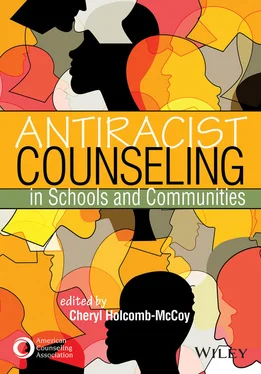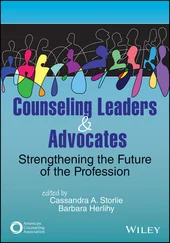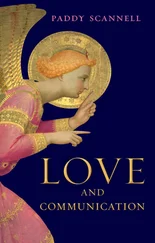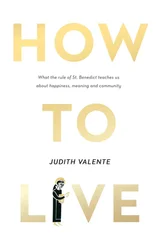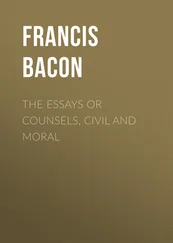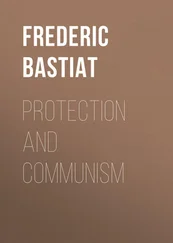In other words, we intend to make a clear distinction between theoretical and pragmatic frameworks of helping (e.g., multicultural counseling, social justice counseling) that suggest Black suffering can be ameliorated or even decelerated through discourses of respect for cultural differences or progressive ideologies of social inclusion. With this as our point of departure, we propose a decolonial theory of counseling that refuses to shy away from the structural nature of social death. Our candor and forthright engagement with social death and decolonial theory represents our desire to abandon Eurocentric scientific paradigms and psychological theories that suggest that adjustment and assimilation to an inherently unjust society, a society that habitually denies people of color access, constitutes psychological health and wellness (King, 1968). By intentionally naming historical events (e.g., the rise of European enlightenment, the formation of the new world) and emphasizing how these events reverberate through and restructure our contemporary colonial context (e.g., the hypersegregation and overpolicing of Black communities), we take up a position, as counselor educators, grounded in an undying and unapologetic love for Black people. This position requires and necessitates radical love and honesty and the eschewing of analytical and theoretical perspectives that obscure and mythicize the terror Black people live through (Washington & Henfield, 2019). We assert that a decolonial theory of counseling (Bulhan, 1990; Fanon, 1963, 2008) must engage concepts like social death, meaning a cancerous colonial context in which Black people are treated as nonbeings and perpetually subjected to gratuitous violence (Patterson, 2018).
We begin by exploring how the gratuitous and whimsical fashion on non-beingness imposed on the Black sentient being has continually helped consolidate the psychological and integrity of other social groups since 642 AD (Judy, 1993). We hope to illuminate disciplines (e.g., Black studies, Indigenous studies) and discourses/frameworks (e.g., decolonization, the master/slave dialectic; Bulhan, 1990; Fanon, 1963) not typically broached in the counseling literature to deepen our understanding of social oppression that manifests as the murders of Ahmaud Arbery, Breonna Taylor, George Floyd, Rayshard Brooks, Tony McDade, and others. We then demonstrate how anthropology, psychology, counseling, and other helping professions provide the ideological sinew that holds colonial and postcolonial social societies intact.
Whiteness in the Counseling Profession
In the 1960s, the proliferation of decolonial, postcolonial, and critical cultural theories across academic discourses and within the general public coincided with prolonged revolutionary struggles for human rights, human dignity, and racial justice (Stanfield, 1985). These struggles for human dignity and racial justice were inspired by streams of radical consciousness that critiqued European colonialism and imperialism, in particular the profound impact European colonialism, neocolonialism, and neo-imperialism have on the material conditions of people of color throughout the world (Fanon, 1963; Morrison, 2017). As part of their work, many decolonial, postcolonial, and critical cultural theories have “fought against the traditional concept of difference” (Guthrie, 2004, p. xiii) by examining the role European enlightenment—a seismic shift in the arc of epistemological and methodological paradigms—played in justifying the physical demarcation (e.g., Manifest Destiny as land seizure) between the old and new worlds/territories (Horne, 2018).
What is pernicious is that the physical boundaries erected between the two territories—the old and new worlds/territories—were supposedly derived from irrefutable scientific evidence—namely, natural anthropological observation and the manipulation of variables through laboratory experiments that demonstrated stark group differences. In his theorization of the psychology of oppression, Bulhan (1990) provided a list of prominent philosophers and psychologists (e.g., David Hume, Thomas Malthus, Francis Galton, Lewis Terman) who, at one point or another, subscribed to and publicly endorsed biological/genetic or cultural discourses/explanations of difference. By compiling the list, Bulhan illustrated how enthralled and deeply invested early theorists and psychologists were in calcifying beliefs that these differences in technological development, for instance, were attributable to biological racial determinism, such as skull shape and size as proxies for intelligence or social deviance, or antiquated and naive sociocultural practices (e.g., correspondence/complementarity/harmony with nature).
Bulhan (1990) pushed the reader to comprehend how these figures and the monumental significance ascribed to their ideas (e.g., Charles Darwin’s doctrine of survival of the fittest, Galton’s politics of sterilization of the unfit, the Malthusian principle of famine and drought as solutions to global oversaturation/overpopulation of inferior people) helped substantiate a Manichean framework that structured the project of modernity (Castro-Gómez & Martin, 2002). The Old World (e.g., Africa as the Dark Continent) was considered a wild, savage, and unbridled space occupied by inadequate/adolescent and inferior beings; conversely, the New World represented refinement, sophistication, and immeasurable opportunities for expansion, prosperity, and wealth accumulation for those deemed acceptable based on Eurocentric standards of decorum, civility, and social life (Castro-Gómez & Martin, 2002; Stanfield, 1985). Promoting this Manichean dichotomy/ doctrine—the irreconcilable differences between the social and cultural practices of the Indigenous, the African, and other peoples of color (e.g., old, primitive, inferior world) and the sociocultural mores of European imperial powers—was of the utmost importance in the formation of the social sciences, psychology notwithstanding (Guthrie, 2004).
In addition, decolonial and postcolonial theories of the 1960s drew parallels between colonial domination that characterized the project of modernity, initiated with Christopher Columbus’s nautical exploit in 1492 (Clarke, 1998), and newer forms of surveillance, subordination, and oppression that were implemented as economic innovation and urbanization bourgeoned in this country (e.g., housing segregation and the confinement of Black people to urban ghettos during early American urban industrialization). For historians of this ilk, it is vital to fully comprehend how European enlightenment—in particular, the emphasis placed on reason and rational thinking as quintessential characteristics of human beings, and in particular, white men (e.g., autonomous and self-governed, individuated, competitive, ruggedly individual, and having a strong work ethic)—helped codify categories and taxonomies of individual and social group difference and social policies that remain salient to this day (e.g., residential and housing segregation).
Quintessential characteristics of European American culture and behavior have been so systematically integrated into psychological nomenclature (e.g., normalcy, abnormality, deviant behavior, approved therapeutic practices) that it is rare when we consider the adverse implications this hegemonic imposition of European American culture has had on the cultural other. As Stanfield (1985) wrote, “Economics, psychology, and sociology were dominated by middle-class white Anglo-Saxon Protestant males who sought to define and explain the human problems produced by the changing socio-economic and political order of their ethnic-based cognition” (pp. 404–405). Grier (2004) corroborated the assertion that psychological nomenclature has been an important and indispensable handmaiden in maintaining the status quo by recreating racial stratification, in particular during critical and socially contentious historical periods in this country (e.g., World War I, European immigration, Black northern migration), when he stated the following:
Читать дальше
